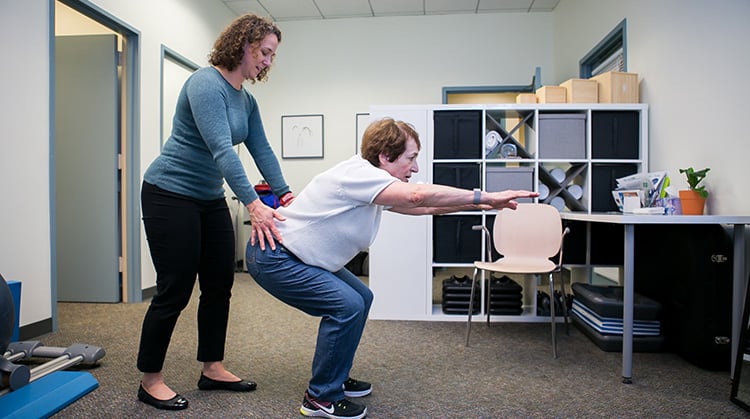
Pain under, around, or at the front of the knee is one of the most common types of knee pain that people experience. If you have visited a health care professional, you may see this documented as “patellofemoral pain.” This type of knee pain occurs among athletes, active teenagers, older adults, people who sit a lot for work, and people who have active and demanding jobs.
Oftentimes, when people experience this type of kneecap pain, it may be caused by weakness or an imbalance in the muscles of the hip and thigh.
A physical therapist will work with you to personalize an exercise plan that can help decrease your pain. Some of the exercises you will be asked to do will focus on strengthening your hips and legs to help prevent or reduce kneecap pain.
Here Are 5 Exercises to Try On Your Own
Make sure that you have a support to hold on to if needed. If these exercises are too easy, be careful to gradually increase the amount of resistance or weight. Increasing the weight or the number of sets or repetitions too quickly can cause or add to your kneecap pain.
If you experience pain or are unable to complete these exercises on your own, seek the help of a medical doctor or physical therapist who will do a thorough exam and develop a personalized treatment plan to address your pain and goals.
Start by trying to do one set (10 times for each exercise), then repeat the exercise for two more sets of 10 to reach a total of three sets for each exercise. Seek advice from a PT on how best to progress with these exercises to challenge yourself further.
1. Squats
- Stand straight with your feet hip-width apart.
- Lower your bottom down and backward, as if you were going to sit in a chair. Stop when your knees reach about a 90-degree angle. Try not to lean your upper body forward more than a few inches. You may want to move your arms forward for balance or stand next to a wall, counter, or other support.
- Straighten your legs to return to standing straight.
- Repeat until you reach your goal.
2. Side leg raises
- Lie on your side with your injured leg on top.
- Slowly raise your injured leg toward the ceiling. You only need to raise your leg 12-24 inches; there is no need to raise your leg as far as you can.
- Hold this position for 10 seconds. You should feel this exercise working the muscles on the outside of your hip.
- Repeat until you reach your goal.
- Repeat on the opposite side.
3. Leg presses
Laying on the floor with the ends of a resistance band or tubing in each hand, bring your knees to your chest. Put the tubing across the bottoms of your feet and take up any slack in the resistance band. Keeping your elbows on the floor and your hands by your chest, slowly press both legs outward, leading with your heels, until your legs are straight. Gently return to a bent-knee position. Repeat until you reach your goal.
4. Step-ups
- Stand tall with feet shoulder-distance apart at the base of a set of stairs (or a step tool designed for step exercises). Hold on to the railing or wall for support.
- Shift your weight to one foot.
- Place your right foot entirely on the step and press yourself up so that your body is up onto the step, placing the left foot next to the right foot on the stair.
- Slowly lower your left foot back to the floor and steady yourself.
- Continue this process with your right foot on the step until you have completed your goal.
- Repeat on the opposite side.
5. Knee extensions
- While sitting on a chair with both feet on the floor hip-width apart, slowly raise one leg out in front of you until it is level with the floor.
- Slowly lower the same leg back to the floor and repeat until you have completed your goal.
- Repeat on the opposite side.
- If this becomes too easy, tie a resistance band or tubing to a chair leg and around your foot to make this exercise more challenging. Remember to increase resistance gradually as you get stronger.
If you need help addressing kneecap pain, a physical therapist can work with you to design a treatment program to help you reach your goals.
Physical therapists are movement experts. They improve quality of life through hands-on care, patient education, and prescribed movement. You can contact a physical therapist directly for an evaluation. To find a physical therapist in your area, visit Find a PT.


